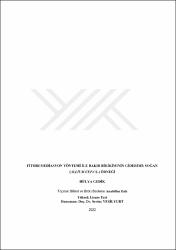| dc.contributor.advisor | Yeşilyurt, Sevinç | |
| dc.contributor.author | Gedik, Hülya | |
| dc.date.accessioned | 2023-04-27T20:40:51Z | |
| dc.date.available | 2023-04-27T20:40:51Z | |
| dc.date.issued | 2022 | |
| dc.identifier.uri | https://tez.yok.gov.tr/UlusalTezMerkezi/TezGoster?key=qVqOZFj2DwNmvdf1oGFYiFzeCQOhZzYfqtjoQtVTs9jVqfEwTQogEuzVxLX7-2g- | |
| dc.identifier.uri | https://hdl.handle.net/20.500.11776/11404 | |
| dc.description.abstract | ÖZET FİTOREMEDİASYON YÖNTEMİ İLE BAKIR BİRİKİMİNİN GİDERİMİ: SOĞAN (ALLİUM CEPA L.) ÖRNEĞİ Hülya GEDİK Toprak Bilimi ve Bitki Besleme Anabilim Dalı Yüksek Lisans Tezi Danışman: Doç. Dr. Sevinç YEŞİLYURT Toprak metal kontaminasyonu, dünya çapında giderek artan sayıda etkilenen alan ve metallerin çevre ve insan sağlığı üzerindeki zararlı etkileri nedeniyle büyük bir endişe kaynağıdır. Biyobozunur olmamaları ve toksisiteleri nedeniyle, daha fazla metal kontaminasyonunu önlemek ve gezegendeki binlerce kontamine alanı iyileştirmek çok önemlidir. Bu sorunlarla mücadele etmek için çevre dostu, kolay uygulanabilir ve maliyeti düşük bir yöntem olarak bilinen fitoremediasyon yöntemi yaygın olarak tercih edilmekte ve bu konuyla ilgili birçok çalışma yapılmaktadır. Bu çalışmada, önemli bir besin kaynağı olan soğan (Allium cepa L.) bitkisinin, yetiştiriciliği, ülkemizdeki durumu değerlendirilmiş ve bakır (Cu) ağır metalinin fitoremadiasyonunda kullanılabilirliği araştırılmıştır. Deneme Tekirdağ Namık Kemal Üniversitesi Ziraat Fakültesi Toprak Bilimi ve Bitki Besleme Bölümü laboratuvarında soğan (Allium cepa L.) bitkisi kullanılarak, 1 bitki x 3 tekerrür x 4 farklı doz (0-30-60-120 mg kg-1 CuSO4.5H2O) bakır uygulaması ile "Tesadüf Blokları Deneme Deseni"ne göre yürütülmüştür. Deneme sonucunda, uygulanan en yüksek bakır içeriği 120 mg kg-1 uygulanan saksılarda yetiştirilen soğan bitkilerinin kök bölgesinde (26,25 mg kg-1) birikim yaptığı tespit edilmiştir. Bitkinin üst aksamındaki ise en yüksek birikim, 30 mg kg-1 doz uygulanan saksılarda 19,16 mg kg-1 bakır olarak bulunmuştur. Bu çalışma sonunda, soğan (Allium cepa L.) bitkisinin topraklardan Cu ağır metalinin temizlenmesinde fitoremediasyon yöntemlerinden biri olan ve bitkinin kök bölgesinde birikim yaptığı fitoekstraksiyonda kullanılabileceği sonucuna varılmıştır. | en_US |
| dc.description.abstract | ABSTRACT PHYTOREMEDIATION METHOD AND REMOVAL OF COPPER ACCUMULATION: EXAMPLE OF ONION (ALLIUM CEPA L.) Hülya GEDİK Department of Soil Science and Plant Nutrition MSc. Thesis Supervisor: Assoc. Prof. Dr. Sevinç YEŞİLYURT Soil metal contamination is the main concern because of the growing number of affected areas around the world and the harmful effects of metals on the environment and living things. Because of the heavy metals' non-biodegradability and toxicity, it is crucial to prevent further metal pollution and rehabilitate the thousands of polluted areas on the earth. In order to fight these problems, the phytoremediation method, which is known as an environmentally friendly, easily applicable, and cost-effective method, is widely preferred and many studies are carried out on this subject. In this study, the cultivation of the onion (Allium cepa L.) plant, which is an important food source, and its situation in our country were evaluated and the usability of phytoremediation for copper (Cu) heavy metal was investigated. The experiment was carried out in Tekirdağ Namık Kemal University, Faculty of Agriculture, Department of Soil Science and Plant Nutrition, using onion (Allium cepa L.) plant, 1 plant x 3 replications x 4 different doses (0-30-60-120 mg kg-1 CuSO4.5H2O) copper. The trial was carried out according to the "Random Blocks Trial Design". As a result of the experiment, it was determined that the onion plants grown in pots with the highest applied copper content of 120 mg kg-1 accumulated copper in the roots (26,25 mg kg-1). The highest accumulation in the above ground part of the onion was found to be 19.16 mg kg-1 copper in pots where a 30 mg kg-1 dose was applied. At the end of this study, it was concluded that the onion (Allium cepa L.) plant can be used in phytoextraction, which is one of the phytoremediation methods, in removing Cu heavy metals from soils. | en_US |
| dc.language.iso | tur | en_US |
| dc.publisher | Tekirdağ Namık Kemal Üniversitesi | en_US |
| dc.rights | info:eu-repo/semantics/openAccess | en_US |
| dc.subject | Bakır | en_US |
| dc.subject | Soğan (Allium cepa L.) | en_US |
| dc.subject | Fitoremediasyon | en_US |
| dc.subject | Toprak kirliliği | en_US |
| dc.subject | Ağır metal | en_US |
| dc.subject | Fitoekstraksiyon | en_US |
| dc.subject | Copper | en_US |
| dc.subject | Onion (Allium cepa L.) | en_US |
| dc.subject | Phytoremediation | en_US |
| dc.subject | Soil pollution | en_US |
| dc.subject | Heavy metal | en_US |
| dc.subject | Phytoextraction | en_US |
| dc.subject | Ziraat | en_US |
| dc.subject | Agriculture | en_US |
| dc.title | Fitoremediasyon yöntemi ile bakır birikiminin giderimi: Soğan (Allium cepa L.) örneği | en_US |
| dc.title.alternative | Phytoremediation method and removal of copper accumulation: Example of onion (Allium cepa L.) | en_US |
| dc.type | masterThesis | en_US |
| dc.department | Enstitüler, Fen Bilimleri Enstitüsü, Toprak Bilimi ve Bitki Besleme Ana Bilim Dalı | en_US |
| dc.identifier.startpage | 1 | en_US |
| dc.identifier.endpage | 81 | en_US |
| dc.institutionauthor | Gedik, Hülya | |
| dc.relation.publicationcategory | Tez | en_US |
| dc.identifier.yoktezid | 768782 | en_US |



















